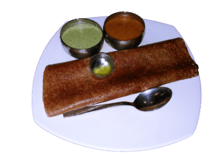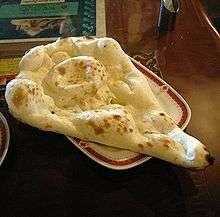Dosa
|
Dosa with chutneys | |
| Course | main dish |
|---|---|
| Place of origin | India |
| Region or state | South India |
| Serving temperature | hot |
| Main ingredients | rice and black gram |
| Variations | Masala Dosa, Rava Dosa, Onion Dosa and many more |
|
| |
Dosa is a type of pancake-crepe made from a fermented batter. Its main ingredients are rice and black gram. Dosa is a typical part of the South Indian diet and popular all over the Indian subcontinent. Traditionally, Dosa is served hot along with sambar and chutney. It can be consumed with idli podi as well.
History
Dosa is indigenous to South India; its exact birthplace in that region is a matter of conjecture.[1] According to food historian K. T. Achaya, dosa (as dosai) was already in use in ancient Tamil country around the 1st century AD, as per references in the Sangam literature.[2] According to P. Thankappan Nair, dosa originated in the Udupi town of present-day Karnataka.[3]
In popular tradition, the origin of dosa is linked to Udupi, probably because of the dish's association with the Udupi restaurants.[1] Also, the original Tamil dosa was softer and thicker. The thinner and crispier version of dosa, which became popular all over India, was first made in present-day Karnataka.[4] A recipe for dosa (as dosaka) can be found in Manasollasa, a 12th-century Sanskrit encyclopedia compiled by Someshvara III, who ruled from present-day Karnataka.[5]
Names

Dosa is known by several names. The standard transliterations and pronunciations of the word in various South Indian languages are as follows:
| Language | Transliteration | Pronunciation (IPA) |
|---|---|---|
| Kannada: ದೋಸೆ | dōse | d̪oːse |
| Malayalam: ദോശ | dōsa | d̪oːɕa |
| Tamil: தோசை | dōsai | t̪oːsʌj |
| Telugu: అట్టు | Aṭṭū | AAːttu |
| Tulu: ದೋಸೆ | dōse | d̪oːse |
| Template:Lang-konkani || polo ||
Nutrition
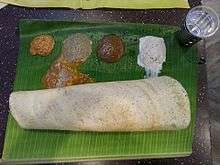
Dosa is high in carbohydrates and contains no added sugars or saturated fats. As its key ingredients are rice and black gram, it is also a good source of protein.[6] The fermentation process increases the vitamin B and vitamin C content.[7] There are also instant mix products for making dosa which usually contain higher amounts of rice.
Preparation
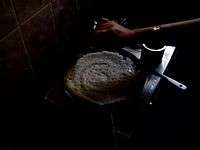
A mixture of rice and black grams that has been soaked in water is ground finely to form a batter. Some add a handful of fenugreek seeds soaked along with the rice. The proportion of rice to lentils is generally 4:1 or 5:1. The batter is allowed to ferment overnight. After the overnight fermentation, the batter is mixed with water to get the desired thickness. The batter is then ladled onto a hot tava (griddle) greased with oil or ghee (clarified butter). It is spread out evenly with the base of a ladle or bowl to form a pancake. A dosa is served hot, either folded in half or rolled like a wrap. It is also usually served with chutney and sambar. The mixture of black grams and rice can be replaced with highly refined wheat flour or semolina.
- Rice batter
 Batter poured on a tava griddle
Batter poured on a tava griddle Batter being spread uniformly
Batter being spread uniformly- After being cooked for some time
Serving
Dosa can be stuffed with fillings of vegetables and sauces to make a quick meal. They are typically served with a vegetarian side dish which varies according to regional and personal preferences. Common side items are:
- Sambar
- Wet chutney: examples include coconut chutney (a semisolid paste made up of coconut, dal (lentils), green chilli and mint or coriander)
- There are variety of chutney served along with Dosai[8]
- Dry chutney (Idli podi or molagapodi): a powder of spices and sometimes desiccated coconut
- Indian pickles
Variations
Though dosa typically refers to the version made with rice and lentils, many other versions exist.
| Name | Key ingredients |
|---|---|
| Masala dosa | spiced potatoes tucked inside the dosa. |
| Mini soya dosa[9] | soya milk and wheat flour[10] |
| Pesarattu (Green Dosa)[11] | green gram[12] |
| Light white dosa | rice and coconut[13] |
| Mysore Masala Dose[14] | rice, black gram, fenugreek seeds |
| Onion Rava Dosa[15] | Semolina, rice flour |
| Ragi Wheat Dosa | Ragi, Whole Wheat Flour[16] |
| Rava dosa | rava or sooji |
| Benne Dose | butter |
| Neer dose | watery rice batter |
| Amboli and Dhirde | In coastal parts of Maharashtra, variations known as amboli and dhirde (or Dhirade) exist. Amboli (like dosa) is prepared with fermented batter, while dhirde is prepared with unfermented batter. |
 Paper Masala Dosa
Paper Masala Dosa Ghee Dosa
Ghee Dosa Cheese dosa served with sambar and coconut chutney
Cheese dosa served with sambar and coconut chutney neer dosa with thick coconut chutney
neer dosa with thick coconut chutney
Masala dosa
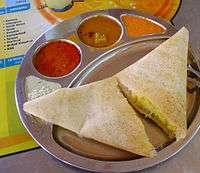
The masala dosa is made by stuffing a dosa with a lightly cooked filling of potatoes, fried onions and spices. The dosa is wrapped around an onion and potato curry or masala. Masala dosa was listed as number 49 on World's 50 most delicious foods compiled by CNN Go in 2011.[17]
Related foods
- Uttapam: a dosa-like dish made from the same batter. Unlike a dosa, which is crisp and unlike relatively soggy crepes, it is a thick pancake mostly topped with diced onions, tomatoes, cilantro or cheese. Uttapam is sometimes characterized as an Indian pizza.
- Pesarattu: a dosa-like preparation prepared from green gram, which is typically served with a ginger and tamarind chutney
- Adai: a dosa-like dish prepared from a combination of lentils, namely black gram, kadalai (Chickpea) and green gram .
- Appam/aappam/hopper : a pancake prepared from a combination of patted rice batter. The center is thicker and the outer rim is very thin. Served with sweet coconut milk.
- Chakuli pitha: batter contains more black gram and less rice flour
- Apam balik: made from a mixture of flour, eggs, sugar, baking soda, coconut milk and water.
- Jianbing: dosa like dish made in china
See also
- Idli
- Vada
- List of fermented foods
- List of Indian breads
- List of pancakes
- Mangalorean cuisine
- Udupi cuisine
References
- 1 2 Charmaine O' Brien (15 December 2013). The Penguin Food Guide to India. Penguin Books Limited. p. 378. ISBN 978-93-5118-575-8.
- ↑ K. T. Achaya. The Story of Our Food. Universities Press. p. 80. ISBN 81-7371-293-X.
- ↑ P. Thankappan Nair (2004). South Indians in Kolkata. Punthi Pustak. p. 320. ISBN 81-86791-50-7.
- ↑ Vir Sanghvi (1 January 2004). Rude Food: The Collected Food Writings of Vir Sanghvi. Penguin Books India. pp. 109–110. ISBN 978-0-14-303139-0.
- ↑ K.T. Achaya (2003). The Story of Our Food. Universities Press. p. 85. ISBN 978-81-7371-293-7.
- ↑ Srilakshmi, B. (2006) [2002]. Nutrition Science (Revised 2nd ed.). New Age International (formerly Wiley Eastern Ltd.). p. 403. ISBN 978-81-224-1633-6. Retrieved 2011-05-22.
- ↑ Nutrition and Dietetics - Higher Secondary - First Year (PDF). Directorate of School Education, Government of Tamil Nadu. 2004. p. 31. Retrieved 2012-08-30.
- ↑ refer the link http://www.chitrasfoodbook.com/2014/10/35-chutney-recipes-sidedish-for-idli.html
- ↑ "Recipe: Mini soya dosa". The Times of India.
- ↑ "Mini Soya Dosa". food.ndtv.com.
- ↑ "Healthy snack recipe: Green Dosa". The Times of India.
- ↑ "Pesarattu (Green Gram Dosa)". food.ndtv.com.
- ↑ "Recipe: Light white dosa". The Times of India.
- ↑ "Mysore Masala Dosa". food.ndtv.com.
- ↑ "Onion Rava Dosa". food.ndtv.com.
- ↑ "Ragi Wheat Dosa". food.ndtv.com.
- ↑ CNN Go World's 50 most delicious foods 21 July 2011.

